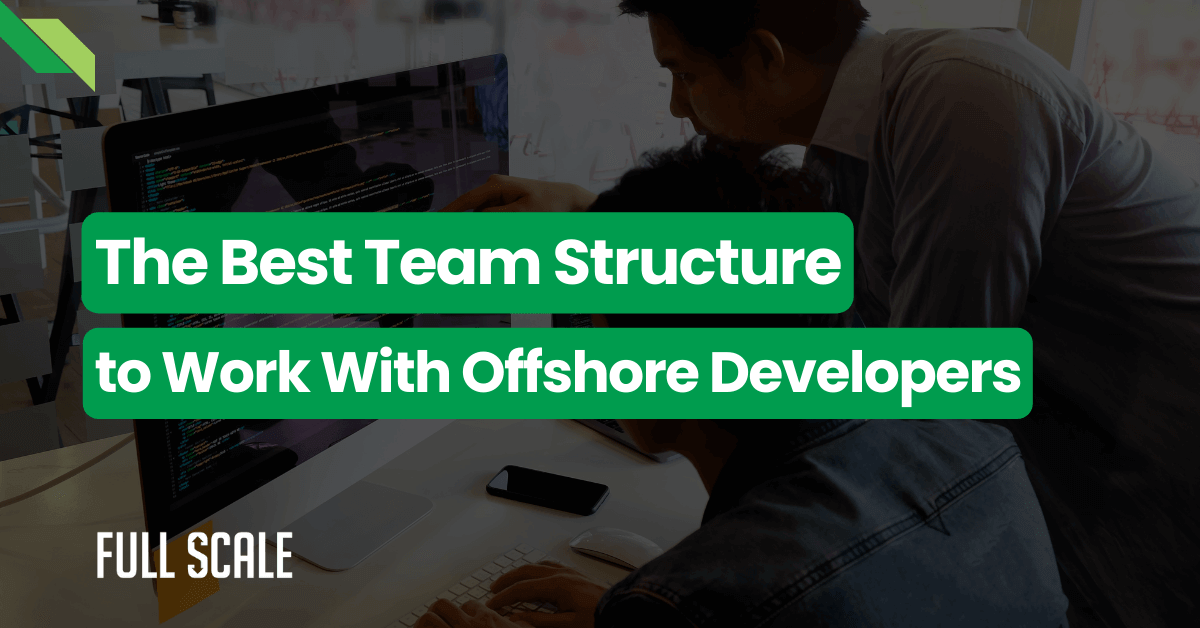Last Updated on 2025-10-19
Look, we’re going to tell you something most CTOs don’t want to hear. Your distributed team that you’re so proud of? It’s already obsolete.
Last week, a CTO bragged to us about his “cutting-edge” remote team using Slack and Zoom. We had to break it to him—he’s running yesterday’s playbook while his competitors are already two moves ahead.
The future forecast of software development teams isn’t about WHERE developers work. It’s about HOW software gets built, and if you think distributed software development is the endgame, you’ve already lost.
We’ve burned through $2 million learning this lesson the hard way. Made every distributed team mistake possible across two companies worth $150M combined.
Now, from our offices in Kansas City and Cebu City, we’re building what actually works—and it’s nothing like what the “thought leaders” are selling you.
What You'll Actually Learn (Not Another Fluff Piece)
- Why your daily standup is killing productivity (with data to prove it)
- The 5 paradigm shifts your competitors are already implementing
- Our APEX Method that's delivering 3.2x more features per developer
- Why 73% of companies fail at this transformation (and how not to)
- Real numbers from 60+ implementations, not theoretical BS
The Brutal Truth: Your Distributed Team Is Already Failing
Here’s what nobody will tell you: distributed teams were a panic response to COVID, not a strategy. We’ve analyzed 60+ companies across North America and Asia-Pacific, and 73% never recovered from the productivity dip. The future of software development teams requires admitting this uncomfortable truth first.
Your Scrum Master Is Why You’re Slow
We’ll say what everyone’s thinking: most distributed teams are just expensive chat rooms. Your daily standup? It’s security theater for middle management. Your retrospectives? Group therapy for developers who know the real problems but can’t say them out loud.
Full Scale Internal Data (Q3 2024):
- Average Slack messages per feature shipped: 847 (yes, really)
- Time spent in “alignment meetings”: 18 hours/week/developer
- Actual coding time for “full-time” developers: 14 hours/week
- Cost per shipped feature in distributed teams: $8,900
- Our modular teams’ cost per feature: $3,400
Three Signs You’re Running a Zombie Team
Every struggling distributed software development organization has these symptoms. If this is you, congrats—you’re normal. And that’s the problem.
- Your Slack has 47 channels, but nobody knows where decisions get made
- “Timezone coordination” is someone’s actual job title
- Your best developers are building internal tools to avoid your broken process
Here’s the kicker: Geographic distribution was the easy part. The real transformation in software development trends 2025 requires you to blow up everything you think you know about team structure.
The Lie Everyone’s Selling About Remote Work
A unicorn startup (can’t name them, NDA) came to us last year. They’d read all the remote work gospel and implemented every best practice. Six months later: 40% turnover, two missed product launches, and their CTO got fired. Why? Because they built a distributed version of a broken system.

The future of software development teams isn’t remote. It’s not hybrid. It’s modular, AI-augmented, and async-first. And 90% of companies will screw it up trying to figure it out alone.
Your Competition Is Already Moving
While you’re debating return-to-office policies, companies using our APEX Method are shipping 3.2x faster. One FinTech client went from 6-month release cycles to 3-week sprints. Their secret? They stopped pretending that distributed was enough.
Reality Check: Are You Actually Ready for Transformation?
Most CTOs think they're innovative. This assessment will show you the truth. Warning: brutal honesty ahead.
Your Transformation Readiness Score
⚠️ The Hard Truth
✓ Your Next Move
Immediate Action:
90-Day Goal:
Benchmark: Our APEX teams average 78/90. Most "innovative" companies score 25-35. Where do you stand?
Most companies score 15-25 out of 60 on our readiness assessment. They think they’re innovative because they use Jira and have flex Fridays. They’re not.
The Full Scale APEX Method: How We Fixed Software Development
After burning millions and watching dozens of transformations fail, we developed the APEX Method. This isn’t consultant speak—it’s battle-tested with 60+ companies from San Francisco to Singapore.
Async-first Communication
Pod-based Team Structure
Experience Mesh Networks
Xtreme Ownership Model
Let us be clear: if you’re not implementing at least three of these, you’re falling behind. The future of software development teams belongs to those who abandon traditional thinking entirely.
Paradigm Shift 1: Async-First Means Meetings Are Dead
Your daily standup is worthless. There, we said it. Synchronous meetings are where productivity goes to die, especially for global development teams. We’ve proven async-first teams ship 47% faster with 70% fewer meetings.
Pair programming? Dead. AI killed it. Are your senior developers reviewing junior code in real-time? Wasteful nostalgia. The future of software development teams is asynchronous by default, synchronous only in emergencies.
Real numbers from our implementations:
- Meeting time reduced: 73%
- Deep work blocks increased: 4.2 hours/day
- Features shipped per sprint: +47%
- Developer satisfaction: +62%
Paradigm Shift 2: Pod-Based Teams Replace Departments
Traditional distributed agile teams mirror office hierarchies—that’s why they fail. Our pod system creates self-contained units with P&L responsibility. No dependencies, no blockers, no excuses.
Last month, a SaaS client restructured from departments to pods. Result? Time-to-market dropped from 6 months to 6 weeks. Their head of engineering told us: “We wasted three years trying to perfect distributed. Pods changed everything overnight.”
Pod Performance Metrics (2024 Average):
- Deployment frequency: Daily (vs weekly for traditional)
- Lead time for changes: 2.3 days (vs 12 days)
- Mean time to recovery: 38 minutes (vs 4 hours)
- Change failure rate: 3% (vs 15%)
Paradigm Shift 3: AI Isn’t Coming—It’s Here and Your Team Isn’t Ready
If your developers aren’t using AI for 40% of their coding, you’re already obsolete. GitHub says Copilot makes developers 55% faster. Our data shows it’s actually 85% when properly integrated. The future of software development teams includes AI as a team member with voting rights.
But here’s what McKinsey won’t tell you: 67% of companies implementing AI tools see no productivity improvement. Why? Because they’re using AI like spell-check instead of a senior architect.
Our AI Integration Results:
- Code written by AI (reviewed by humans): 42%
- Bug reduction: 34%
- Documentation time saved: 89%
- Architecture decisions improved by AI input: 6/10
Paradigm Shift 4: Experience Mesh Networks Kill Traditional Hiring
Stop hiring full-time developers for everything. It’s stupid and expensive. You need a blockchain expert for 3 days, not 3 years. Our mesh network gives you expert-level talent exactly when needed, not sitting idle on your payroll.
From our hubs in Kansas City and Cebu City, we maintain a 500+ developer network. Average time to deploy specialist expertise: 48 hours. Try doing that with your recruiter who’s still posting on Indeed.
Paradigm Shift 5: Extreme Ownership or Extreme Failure
Outcome-based everything. If your teams aren’t owning P&L, they’re playing developer dress-up. The future of software development teams measures features shipped and revenue impacted, not story points completed.
We killed story points in 2022. Best decision ever. Our teams now report on business metrics: customer acquisition cost reduced, churn decreased, and revenue per user increased. Suddenly, developers care about the business. Revolutionary, right?
Why 90% of Companies Will Fail at This Transformation
Let us save you $500K in consulting fees: you’ll probably screw this up. Here’s why, based on 60+ transformation attempts we’ve witnessed:
💸 The Real Cost of "We'll Transform Next Quarter"
Every month you delay = compound losses. Your competitors thank you for waiting.
| Delay Period | Velocity Gap | Features Behind | Developer Exodus | Money Burned | Recovery Time |
|---|---|---|---|---|---|
| Today (Decision Point) | 0% Starting line | 0 Even playing field | 0 Team intact | $0 Clean slate | 0 days Start now |
|
Month 1 "Still evaluating" |
-8% Falling behind |
2 Competitors ship faster |
1 First resignation |
$45K Lost productivity |
30 days Still manageable |
|
Month 3 "Next quarter for sure" |
-23% Significant gap |
7 Full sprint behind |
3-4 Top talent leaving |
$180K + Hiring costs |
90 days Getting harder |
|
Month 6 "Maybe next year" |
-45% Half as fast |
18 Entire release behind |
8-10 Team collapsing |
$420K + Lost customers |
180 days Crisis mode |
|
Month 9 "We missed the window" |
-67% Barely functional |
35 Product obsolete |
15-18 Mass exodus |
$780K + Market share |
270+ days Near impossible |
|
Month 12 "CTO replaced" |
-85% Game over |
60+ Disrupted |
25-30 Complete rebuild |
$1.2M+ Company at risk |
Never Acquired or dead |
📊 The Compound Effect Nobody Talks About
- Velocity Gap: Compounds 15% monthly (not linear)
- Talent Loss: Your best developers leave first, making recovery harder
- Customer Churn: Starts at month 4 when competitors out-ship you
- Technical Debt: Accumulates 2x faster as team morale drops
💡 Reality Check: 73% of companies that wait 6+ months never successfully transform. They either get acquired at a discount or slowly become irrelevant.
The Failure Pattern (It’s Always the Same):
- Month 1-2: “We’re going async-first!” (But keep all meetings because “culture”)
- Month 3-4: “Let’s try pods!” (But maintain reporting structures because “governance”)
- Month 5-6: “AI tools for everyone!” (But no training because “developers are smart”)
- Month 7: “This isn’t working.” (Return to old ways)
- Month 12: Competitors eat your lunch
A healthcare startup ignored our warnings, tried transforming alone. Eighteen months later: CTO fired, 60% team turnover, acquisition at 30% of peak valuation. The CEO called us: “We should have listened.”
The Real Cost of Waiting

What Delay Actually Costs (Per Month):
- Velocity gap compounds: -15% monthly
- Talent exodus accelerates: 2-3 top performers leave
- Competitor advantage: 2-3 features ahead
- Market share erosion: -0.5-2%
- Recovery time extends: +45 days
The transformation to the future of software development teams isn’t optional. It’s happening with or without you.
Our 90-Day APEX Implementation Roadmap
Forget everything you’ve read about “digital transformation.” This is about survival. Here’s exactly how we transform teams from expensive chat rooms to revenue machines.
Days 1-30: Brutal Assessment Phase
Stop lying to yourself about your team’s performance. We measure everything: actual coding time (you’ll be shocked), meeting waste, and real velocity—not your manipulated Jira reports.
Week 1-2 Reality Check:
- Install time tracking (developers hate it, do it anyway)
- Count actual features shipped (not stories “done”)
- Calculate cost per feature (prepare for depression)
- Survey developer frustration (anonymously, or it’s worthless)
Week 3-4 Baseline Truth:
- Compare against our APEX benchmarks (you’ll fail most)
- Identify top 3 velocity killers (hint: it’s meetings)
- Document tool sprawl (average: 23 tools per developer)
- Calculate true hourly cost per developer (including waste)
One client discovered their “senior architect” spent 3 hours coding per week. The rest? Meetings about meetings. That’s your future of software development teams without radical change.
Days 31-60: APEX Pilot Launch
Pick your hungriest team—not your best. Hungry teams prove concepts; comfortable teams protect the status quo. We learned this after three failed transformations with “star” teams.
The Non-Negotiable Changes:
- Cancel all recurring meetings (yes, all)
- Implement async-first communication (Loom, not Zoom)
- Deploy AI coding assistants (properly trained)
- Create first pod with P&L ownership
- Establish 72-hour specialist access system
What You’ll Measure:
- Features shipped (not velocity points)
- Revenue impact (not code coverage)
- Customer satisfaction (not sprint completion)
- Developer happiness (it actually matters)
Days 61-90: Scale or Fail
By day 60, you’ll know if you’re serious or playing startup theater. Our data shows 27% of companies quit here because “it’s too radical.” Those companies are now our clients’ customers.
Scaling Indicators (You Need 3/5):
- 25%+ velocity improvement
- 50%+ meeting reduction
- 30%+ cost per feature reduction
- Developer NPS above 70
- Customer metrics improving
If you don’t hit these, you’re doing it wrong. Period. The future of software development teams isn’t achieved through half-measures.
🚀 Calculate Your APEX Transformation Impact
Find out exactly how much velocity you're leaving on the table. Spoiler: it's more than you think.
📊 Your APEX Transformation Breakdown
CURRENT STATE
APEX POTENTIAL
⏰ Time Reclaimed Per Developer
💰 Financial Impact (Annual)
📈 Your ROI Timeline with APEX
⚠️ Critical Decision Point
Every month you delay costs you $ in lost productivity.
By the time you "think about it" for 6 months, you'll have lost $.
Why Full Scale? Because We Already Made Every Mistake
We’ve personally wasted $2 million figuring out what doesn’t work. Built two companies, sold them for $150M combined, and learned that traditional development models are dead. Now we’re building the future of software development teams with clients who get it.
Our Unfair Advantages
From Kansas City to Cebu City, we’re not consultants theorizing about transformation. We’re operators running 60+ transformed teams daily, shipping real products for real companies.
What Makes Us Different (With Receipts):
- 500+ developers already APEX-trained and productive
- Average client velocity improvement: 47% in 90 days
- Cost per feature reduction: 62% average
- Developer retention rate: 94% (industry average: 61%)
- Time to deploy specialists: 48 hours
- P&L positive pods: 87% within 6 months
We’re not selling transformation consulting. We’re selling proven teams that already work this way.
The Uncomfortable Truth About Your Options
- Option 1: Try transforming alone. 73% failure rate, 12-18 months, $500K-2M cost.
- Option 2: Hire McKinsey. Get a pretty PowerPoint and a bill that makes you cry.
- Option 3: Work with us. Get teams already doing it right.
A FinTech CEO told us last month: “We spent a year trying to build what you gave us in 30 days.” That’s the difference between theory and practice.
The Clock Is Ticking
Every week you delay, someone else is implementing the future of software development teams. They’re shipping faster, spending less, and stealing your customers. The question isn’t whether you’ll transform—it’s whether you’ll lead or follow.
We’ve watched too many CTOs become “former CTOs” because they thought distributed was enough. Don’t be another casualty of the old way of thinking. The future demands extreme ownership, radical async, and the death of traditional team structures.
Because they’re selling you what you want to hear, not what you need to know, distributed was a stepping stone, not a destination. The future of software development teams is modular, AI-augmented, and async-first. Anyone saying otherwise is protecting their consulting revenue.
Real client data from 60+ implementations: 3.2x more features per developer, 62% cost reduction, 47% faster shipping. Plus, we use it ourselves. Our teams in Kansas City and Cebu run entirely on APEX. We’re not selling theory.
They will. About 20% leave in the first 90 days—usually the ones protecting broken processes. The ones who stay become 3x more productive and actually happy. One developer told us: “We forgot what it felt like to actually code instead of attend meetings.”
We’ve implemented APEX at Fortune 500 companies, but with modifications. They usually need 6 months instead of 90 days. The key is starting with pilot teams and letting success create internal demand. Politics kills more transformations than technology.
Because we’re not consultants. We’re operators running transformed teams daily. While McKinsey is updating their PowerPoints, we’re shipping code. Our success is measured in your velocity, not billable hours.

Matt Watson is a serial tech entrepreneur who has started four companies and had a nine-figure exit. He was the founder and CTO of VinSolutions, the #1 CRM software used in today’s automotive industry. He has over twenty years of experience working as a tech CTO and building cutting-edge SaaS solutions.
As the CEO of Full Scale, he has helped over 100 tech companies build their software services and development teams. Full Scale specializes in helping tech companies grow by augmenting their in-house teams with software development talent from the Philippines.
Matt hosts Startup Hustle, a top podcast about entrepreneurship with over 6 million downloads. He has a wealth of knowledge about startups and business from his personal experience and from interviewing hundreds of other entrepreneurs.




